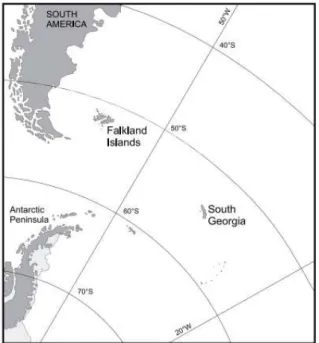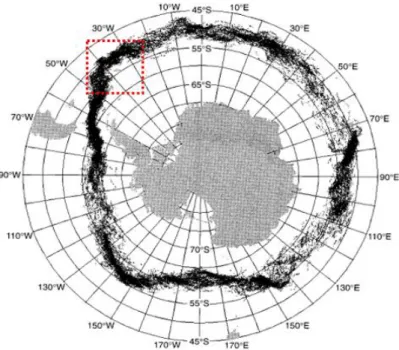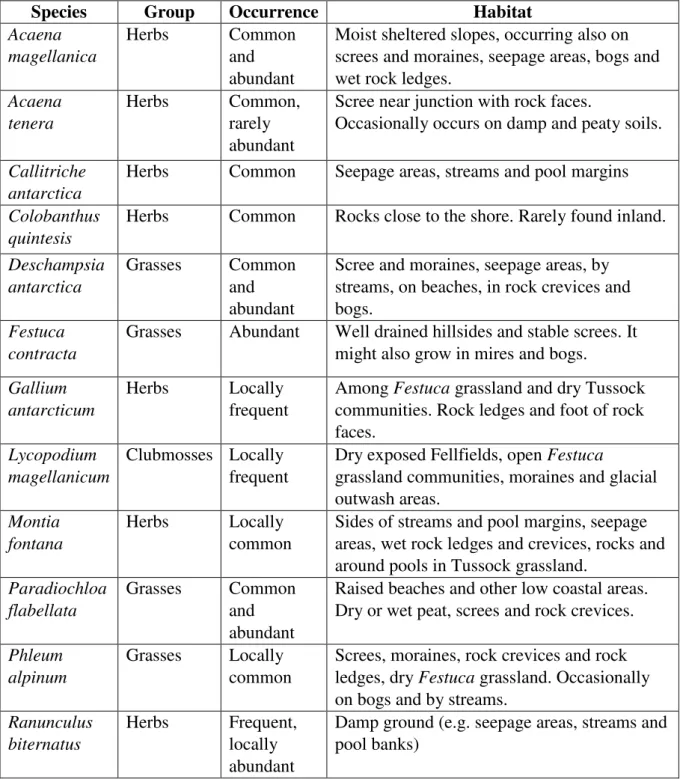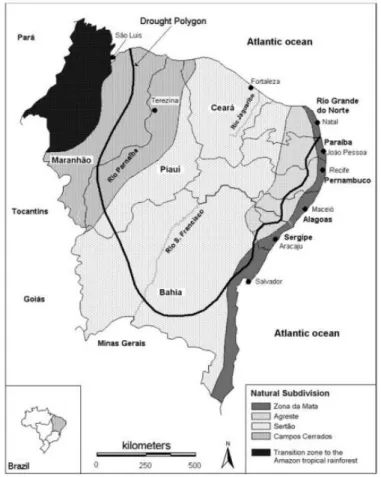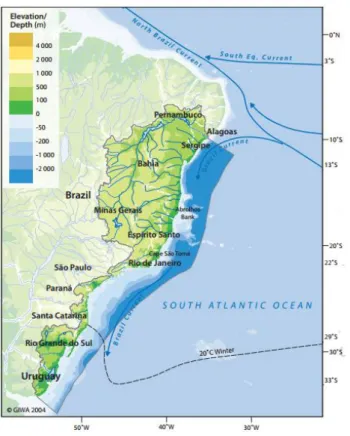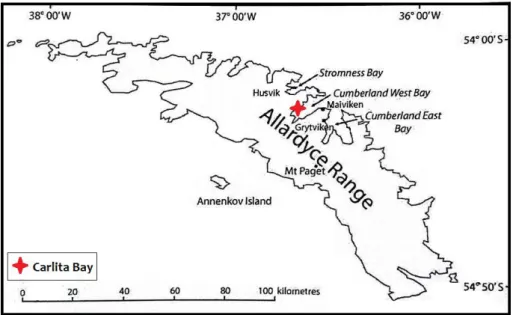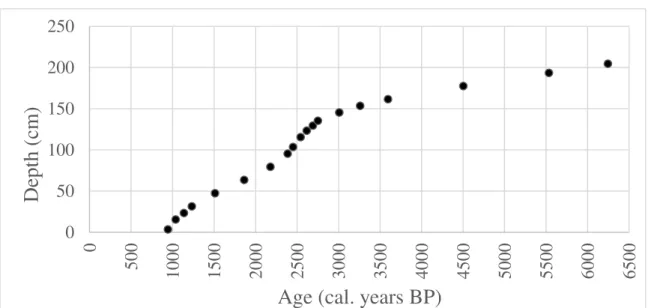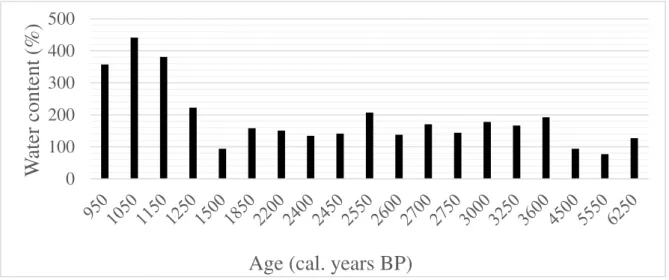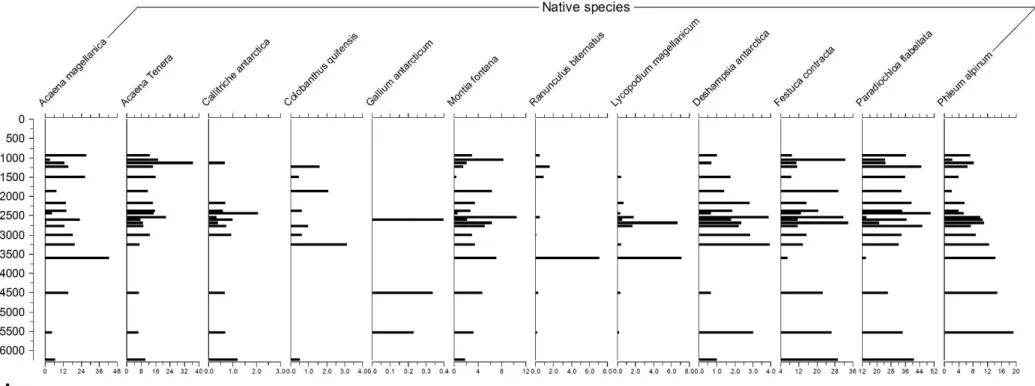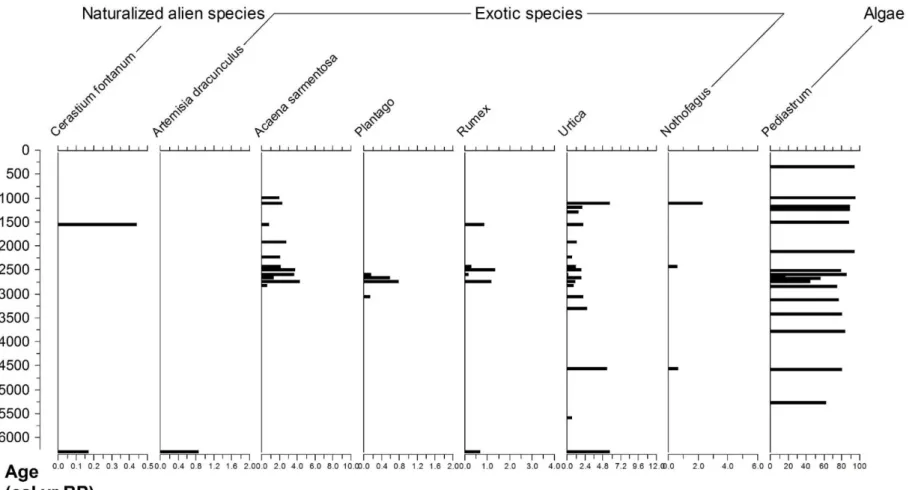UNIVERSIDADE FEDERAL DO CEARÁ INSTITUTO DE CIÊNCIAS DO MAR
CAMENA TIARA FERNANDES COSTA
VEGETATION AND ENVIRONMENTAL HISTORY OF LAKE DIAMOND, SOUTH GEORGIA – ANTARCTICA COMPARED TO NORTHEASTERN BRAZIL
FORTALEZA
CAMENA TIARA FERNANDES COSTA
VEGETATION AND ENVIRONMENTAL HISTORY OF LAKE DIAMOND, SOUTH GEORGIA – ANTARCTICA COMPARED TO NORTHEASTERN BRAZIL
Trabalho de Conclusão de Curso apresentado ao curso de Bacharelado em Oceanografia do Instituto de Ciências do Mar da Universidade Federal do Ceará.
Orientador:. Prof. Dr. Luiz Drude Lacerda Coorientador: Profa. Dra. Anne Elisabeth Bjune.
CAMENA TIARA FERNANDES COSTA
VEGETATION AND ENVIRONMENTAL HISTORY FROM LAKE DIAMOND, SOUTH GEORGIA – ANTARCTICA COMPARED TO NORTHEASTERN BRAZIL
Trabalho de Conclusão de Curso apresentado ao curso de Bacharelado em Oceanografia do Instituto de Ciências do Mar da Universidade Federal do Ceará.
Aprovada em: __/__/____
BANCA EXAMINADORA
________________________________________ Profa. Dra. Anne Elisabeth Bjune
Universitetet i Bergen (UiB)
_________________________________________ Prof. Dr. Luiz Drude de Lacerda
Universidade Federal do Ceará-UFC
_________________________________________ Prof. Dr. Marcelo de Oliveira Soares
ACKNOWLEDGMENTS
I would like to thank Prof. Dr. Anne Elisabeth Bjune, Lea Toska Oppedal and the University of Bergen for all the scientific outcomes, teaching and support related to this research, such as for all the attention and welcoming during my year living in Norway.
I would also like to thank CAPES, for financing my staying in Norway during the Science without Borders programme, one of the best experiences I have had in my life: an experience that not only provided me scientific knowledge, but that also allowed me to become a different and stronger person.
Thanks to Prof. Dr. Luiz Drude de Lacerda, Prof. Dr. Rozane Marins and Prof. Dr. Bruno Turcq, for supervising me with attention and care, allowing the connection between Norway and Brazil in the outcomes of this research and enriching my studies.
Then, I would like to thank my parents, Elaine Cristine and Pedro Eymar, for teaching me how to see the world in a way that was always artistic somehow, turning even the most scientific approach in a potential poem.
“There is a pleasure in the pathless woods
There is a rapture on the lonely shore
There is society, where none intrudes
By the deep Sea, and music in its roar:
I love not Man the less, but Nature more.”
ABSTRACT
This study attempts to reconstruct the environment and vegetation evolution of South Georgia, a sub-Antarctic island, during the last 6000 years of the Holocene. The research is based on water content, loss-on-ignition and pollen analysis of a sediment core from Lake Diamond, Northeastern of the island. Native, naturalized and exotic species are considered on the counting, and pollen diagrams are presented based on percentages of the pollen assemblages. The genus Acaena and native grasses seem to be present throughout the period analysed and present the higher percentages. Exotic species are also observed and their transport relates either to oceanic and atmospheric forces. A reconstruction of climatic events during the Holocene is presented based on the changes on the pollen assemblages. The results are compared to Northeastern Brazil, and the importance of oceanographic and atmospheric forces are suggested as possible teleconnections between the two study areas.
RESUMO
O presente estudo pretende reconstruir a evolução ambiental e vegetacional da Geórgia do Sul, uma ilha sub-Antártica, durante os últimos 6000 anos do Holoceno. A pesquisa é baseada em conteúdo de água, perca por ignição e análise de pólen de um testemunho de sedimento do Lago Diamante, nordeste da ilha. Espécies naturalizas, nativas e exóticas são consideradas na contagem de pólen e diagramas são apresentados com base nos percentuais das assembleias de pólen.O gênero Acaena e gramíneas nativas parecem estar presentes durante todo o período analisado e apresentam os maiores percentuais.Espécies exóticas também são observadas, e seu transporte está relacionado tanto a forçantes oceânicas quanto atmosféricas. Uma reconstrução de eventos climáticos durante o Holoceno é apresentada com base nas mudanças nas assembléias de pólen.Os resultados são comparados ao Nordeste Brasileiro, e a importância de forçantes oceânicas e atmosféricas são sugeridas como possíveis teleconexões entre as duas áreas de estudo.
Palavras-chave: 1. Holoceno 2. Pólen 3. Geórgia do Sul
LIST OF FIGURES
Figure 1 - Location of South Georgia within the Southern Ocean and its vicinity to Antarctic Peninsula, South America and the Falkland Islands, pg. 16.
Figure 2 - The paths of the Polar front between 1987-1993. The red dotted area shows the surroundings of South Georgia., pg. 17.
Figure 3. Location of Northeastern Brazil (Nordeste) and its states and main rivers (Paranaíba, São Francisco and Jaguaribe). The Drought Polygon is also represented in the figure. pg. 20 Figure 4. Ocean currents acting in the Brazilian coast. pg. 21
Figure 5 - South Georgia Map. Carlita Bay, where Lake Diamond is located, is indicated by
the red symbol. In the map some, “Allardyce Range” refers to the mountain range that lies
behind Cumberland West and East Bays. pg. 22.
Figure 6 - Lake Diamond in South Georgia, Antarctica. pg. 22.
Figure 7 - Ages calculated in calibrated years BP measured for the samples of the core sediment that were also taken for counting pollen fossil assemblages, pg. 28.
Figure 8 - Water content (%) present in the samples of the sediment core from Lake Diamond, South Georgia, pg. 29.
Figure 9 - Loss on ignition – LOI (%) used as an estimative of organic matter in the samples of the sediment core from Lake Diamond, South Georgia. pg. 29.
Figure 10 – Pollen diagram I. Percentage numbers of total pollen sum – Native species and their pollen assemblages variations along time. Pg. 31
Figure 11 - Pollen diagram II. Pollen diagram II. Percentage numbers of total pollen sum – Exotic and naturalized alien species and their pollen assemblages variations along time.
Pediastrum is shown in the category ‘algae’. pg. 32.
Figure 12 - Pollen diagram III. Percentage numbers of total pollen sum in the assemblages of Herbs, Grasses and Clubmosses. In the diagram only native and naturalized alien species are present. pg. 33.
Figure 14. Nothofagus found in one of the samples, around 2500 yr BP (a) and in another sample, around 1000 yr BP (b).. pg. 38
Figure 15. The 2700 yr BP event. A) Sediment accumulation rates in Brazilian Amazonia; B) Climatic conditions (wet/dry) in Northeastern Brazil; C) Palaeocurrent record of
Iceland-Scotland Overflow Water (ISOW); D) Atmospheric Δ14C as indicator of solar irradiance.
Shaded area indicates the 2700 yr BP event. Pg. 41
LIST OF CATALOGUES
Catalogue I – Pollen catalogue of native and naturalized alien species occurring in South Georgia, pg. 25
LIST OF EQUATIONS
LIST OF TABLES
Table 1 - Description of species occurring in South Georgia according to Galbraith (2011) in
SUMMARY
1. Introduction ……….. 16
1.1 Geographic settings of South Georgia ………. 16
1.2 Oceanographic context of South Georgia ...………. 16 1.3. Vegetation of South Georgia ………... 17 1.4. Paleoecology and Palynological studies in South Georgia ………. 19 1.5. Geographic settings and oceanographic context in Northeastern Brazil ………. 19
2. Methodology ……….. 22
3. Results ………....……….... 25
3.1 Pollen catalogue for native and naturalized alien species ……… 25 3.2 Pollen catalogue for exotic species ……….. 26 3.3 Age, water content and %LOI ………....….. 28
3.4 Pollen diagrams I (Native species), II (Naturalized and alien species; Algae) and III (Herbs, Clubmosses and Grass) ……….………...… 30
3.5 Pollen accumulative rates and deposition time ………....… 35
4. Discussion …………...………...… 36
4.1 Species as indicators of climate and environment evolution ……… 36
4.2 Exotic species as evidence of long-distance transport ………. 37
4.3 Pediastrum and lake evolution ………. 38
4.4 Pollen accumulative rates and loss-on-ignition ………...…………. 39
4.5. Comparison to Northeastern Brazil ……….………... 39
4.6 Summary of discussion ……… 42
5. Conclusions ………...……… 44
References …………...………... 45
1 INTRODUCTION
1.1. Geographic settings of South Georgia
South Georgia is a sub-Antarctic island that lies between 53.58°S and 54.53°S. Icefields and glaciers are present and cover around 60% of the island (Galbraith, 2011). The temperatures are low, being on average around 2°C throughout the year, reaching its maximum on February (mean temperature equal to 5.6°C) and its minimum on August (mean temperature equal to -1.2°C) (Van der Putten et al, 2004). The cold oceanic climate (Barrow, 1978) and the low temperatures, combined to an annual precipitation varying from 1000 to 2000mm, leach the soils in an extensive way, and the accumulation of peat is quite common, being up to 5m thick in some areas (Galbraith, 2011).
Figure 1. Location of South Georgia within the Southern Ocean and its vicinity to Antarctic Peninsula, South America and the Falkland Islands.
Source: Modified from Bell (2010) and Headland (1984). 1.2. Oceanographic context of South Georgia
South Georgia lies ca. 350 km south from the Antarctic Convergence (Rosqvist & Schuber, 2003), which is affected by three major forces: ocean bathymetry, winds and cold surface water dynamics, and which is also a useful indicator of glaciation degrees (Barrow, 1978). Regarding the fronts present on the Antarctic Circumpolar Current (ACC), South
characterized by an eastward flow and water properties delimiting the northern reach of shallow waters temperature minimum (Talley et al, 2011).
Figure 2. The paths of the Polar front between 1987-1993. The red dotted area shows the surroundings of South Georgia.
Source: Modified from Moore et al., 1999.
The wind pattern acting on the region is also relevant for the climate, and the position of South Georgia within the core belt of the Southern Hemisphere Westerlies Winds (SHWW) (Strother et al, 2015) is useful for reconstructing the strength of past westerlies. Indeed, previous studies have been done considering the conductivity of lakes and ponds in sub-Antarctic islands such as South Georgia, in order to compare the strength of the winds with the major influence of sea-spray forced by them (Saunders et al, 2015).
1.3. Vegetation of South Georgia
The vegetation in the island is influenced mainly by altitude and regional climates, and the topography and habitats present there create intermediate zones, with features being shared between adjacent communities (Poncet et al, 2006). Galbraith (2011) described the native species occurring in South Georgia and divided them between six principal major habitats and vegetation types (Table 1):
b) Coastal flats and slopes –Paradiochloa flabellata, Deschampsia antarctica.
c) Inland Hillsides and Vallnditey Slopes – Festuca contracta, Parodiochloa flabellate, Acaena magellanica.
d) Seepage Slopes and Valley Floors –Acaena magellanica.
e) Glacial Deposits, Scree and Inland Rock –Lycopodium magellanicum. f) Sea Cliffs – Encrusting lichens.
Table 1. Description of species occurring in South Georgia according to Galbraith (2011) in
“A Field Guide to the Flora of South Georgia”.
Species Group Occurrence Habitat Acaena
magellanica
Herbs Common
and abundant
Moist sheltered slopes, occurring also on screes and moraines, seepage areas, bogs and wet rock ledges.
Acaena tenera
Herbs Common, rarely abundant
Scree near junction with rock faces.
Occasionally occurs on damp and peaty soils.
Callitriche antarctica
Herbs Common Seepage areas, streams and pool margins Colobanthus
quintesis
Herbs Common Rocks close to the shore. Rarely found inland.
Deschampsia antarctica
Grasses Common and abundant
Scree and moraines, seepage areas, by streams, on beaches, in rock crevices and bogs.
Festuca contracta
Grasses Abundant Well drained hillsides and stable screes. It might also grow in mires and bogs. Gallium
antarcticum
Herbs Locally frequent
Among Festuca grassland and dry Tussock communities. Rock ledges and foot of rock faces.
Lycopodium magellanicum
Clubmosses Locally frequent
Dry exposed Fellfields, open Festuca
grassland communities, moraines and glacial outwash areas.
Montia fontana
Herbs Locally common
Sides of streams and pool margins, seepage areas, wet rock ledges and crevices, rocks and around pools in Tussock grassland.
Paradiochloa flabellata
Grasses Common and abundant
Raised beaches and other low coastal areas. Dry or wet peat, screes and rock crevices. Phleum
alpinum
Grasses Locally common
Screes, moraines, rock crevices and rock ledges, dry Festuca grassland. Occasionally on bogs and by streams.
Ranunculus biternatus
Herbs Frequent, locally abundant
Cerastium fontanum, a herb species also considered on this study, was not described by Galbraith as a native species, but as a naturalized alien vascular plant very restrict on South Georgia environment. Juncus and Rostkovia magellanica, both flowering plants, are common native species in the island, but their pollen grains are not conserved in fossil assemblages (Van der Putten et al, 2004) and therefore are not considered on this palaeoecological study.
1.4. Palaeoecology and palynological studies in South Georgia
Palaeoecology utilizes proxies (such as pollen, bones and shells, for instance) in order to reconstruct past environments, what allows scientists to comprehend how ecosystems have been changing along years and how these changes could relate to climate and geological cycles. Palaeoecological studies provide, therefore, a useful background for modelling and predicting future scenarios. Considering that the Southern Ocean (where South Georgia is located) has been warming with oceanographic aspects changing and that air temperatures has been rising affecting sea-ice (Jacob, 2006), it is valuable to develop this kind of study.
Palynological researches, such as the one developed on this project, utilizes pollen samples as microfossils that represent the ecology of the past environments. Knowing the ecological characteristics of the species allows making some assumptions: for instance, equal conditions might have been observed before, in order to provide successful growing for the species. Indeed, previous studies have shown, according to palynological results, that before the last two Quaternary glacial episodes the vegetation and the climate in South Georgia were quite similar to what is observed today (Scott et al, 2011).
When environmental reconstruction is made using pollen as reference material, the reconstruction applies to a regional interpretation of the results rather than a local one, since pollen spreads quite easily with the wind or by animal transport, for example, and therefore can travel long distances.
1.5 Geographic settings and oceanographic context in Northeastern Brazil.
7 to 8 months and annual mean precipitations quite low, varying from 280 to 800mm (Oliveira et al, 1999).
Figure 3. Location of Northeastern Brazil (Nordeste) and its states and main rivers (Paranaíba, São Francisco and Jaguaribe). The Drought Polygon is also represented in the
figure.
Source: Modified from Sietz et al. (2006).
The predominant vegetation in Nordeste is the ‘Caatinga’, a biome that includes plants
adapted to arid and semi-arid climatic conditions (IBGE, 2012). According to Kuhlmann (1977), caatinga consists of a xerophytic vegetation, adapted to dry areas, containing shrubs and spiny deciduous trees, and also succulent plants and cacti. Even though drier biomes are predominantly found in lowland areas, in some mountainous areas of Northeastern Brazil it is possible to observe the presence of tropical rain forest, which seems to have persisted in the driest region of Brazil throughout the Holocene, constituting some ‘microrefugia’ (Montade et al, 2014).
According to Uvo and Bernsdtsson (1996), the following mechanisms can be cited as important factors to Northeastern Brazil atmospheric system: the ITCZ (Intertropical Convergence Zone), the SST (sea-surface temperature) and also the El Niño Southern Oscillation (ENSO). The ITCZ, which is affected by the SST, seems to be the most important mechanism, consisting on the confluence of the trade winds from Northern and Southern Hemisphere (Ferreira & Mello, 2005) and being stronger above Northeastern Brazil when the mean sea-surface temperatures in the region present higher values. The consequence when the ITCZ is stronger above Northeastern Brazil is an increase in rainfall. On the other hand, during ENSO events, is observed a decrease in rainfall.
The ocean wind-driven currents observed in Northeastern Brazil is the North Brazil Current and the Brazil Current as shown in Figure 4, both western boundary currents, characterized for being warm and fast currents.
Figure 4. Ocean currents acting in the Brazilian coast.
Source: Modified from UNEP (2004).
2 METHODOLOGY
A sediment core was taken in December 2011 from the bottom of Lake Diamond, 13m elevated above sea level, located in Carlita Bay, South Georgia (S 54°14,138’ W 036°38,856’). Subsamples were taken from the core in order to analyse water content (%), loss-on-ignition (%), 14C dates and fossil pollen assemblages.
Figure 5. South Georgia Map. Carlita Bay, where Lake Diamond is located, is indicated by the red symbol. In the map some, “Allardyce Range” refers to the mountain range that lies
behind Cumberland West and East Bays.
Source: Modified from Van der Putten et al., 2009.
Figure 6. Lake Diamond in South Georgia, Antarctica.
Sourcet: Anne Elisabeth Bjune.
percentage resulting from the dry and burned (550°C) sediment: the samples and the dishes where the samples were placed were weighed before and after being dried in the oven, then burned at 550°C. The difference between the dry weights and the remains after the burning process lead to the percentage loss-on-ignition. The water content was determined by loss on mass after the first drying process, and expressed in percentages. The main difference between the calculation of LOI (%) and water content (%) is given by the following equations:
Equations I and II. Equation I represents the dry matter (LOI %) and Equation II the water content. The fractions are both multiplied by f (f = 100), which is a conversion factor to give the result in percentages. Ma = mas of the empty dish; Mb = mass of the dish containing the entire sample; Mc = mass of the dish containing the dry sample (all of the three are given in
grams).
Source: Modified from Energieonderzoek Centrum Nederland (2003).
The ages of the samples were calculated based on the radiocarbon dating of terrestrial macrofossils, considering 1 cm selected intervals in the sediment core. Samples were sieved at
125 μm in order to extract the macrofossils. The samples were then dried at room temperature. The AMS radiocarbon dating took place at Poznan Radiocarbon Laboratory. (Oppedal, 2016, unpublished).
For the subsampling for pollen analysis, 19 samples were taken from the sediment core and marker spores (Lycopodium clavatum) was added to them. They went through deflocculation and were then boiled with 10% KOH. Coarse particles, silicate and cellulose were removed and the samples were filtered. They went through staining and then the slides for microscope analysis were mounted.
On the same period that the sediment core was taken, pollen from main species (Acaena magellanica, Acaena tenera, Callitriche antarctica, Cerastium fontanum, Colobanthus
quintesis, Deschampsia antarctica, Festuca contracta, Gallium antarcticum, Lycopodium
magellanicum, Montia fontana, Parodiochloa flabellate, Phleum alpinum, Ranunculus
The first part of the laboratory work consisted on recognizing and getting familiar to the species using a microscope. A comparative catalogue of pictures was prepared in order to be used as reference material during the counting of the pollen assemblages. A literature survey was then made for identifying possible exotic species that could appear on the samples, and another catalogue was developed for the exotic species (Acacia, Ambrosia, Artemisia dracunculus, Myrtus communis, Olea, Plantago, Acaena sarmentosa, Rumex, Urtica dioica), using for microscope analysis pollen grains present on the database of the laboratory. It is important to consider that not all the possible exotic species were available in the database, and posterior recognition was made for not-identified pollen grains.
Once the reference catalogues were ready, the fossil samples were counted and a pollen diagram was created. For each sample, a pollen sum was calculated (including all the native, naturalized and exotic species, but Pediastrum, for it being an algae) and then the percentage of each species/type per sample. The pollen accumulative rates were calculated only for native/naturalized species, and it was based on the sample volume (1 cm³), number of added marker (Lycopodium clavatum) tablets (4), and the number of spores in each tablet (18584). The deposition time, corresponding to how many years 1cm takes to accumulate, was calculated based on the age of each sample.
3 RESULTS
3.1. Pollen catalogue for native and naturalized alien species occurring in South Georgia.
The catalogue included fourteen species and some of the pictures are presented below, each letter corresponding to one species. Polystichum mohrioides, even though presented here, was not found in any of the samples.
a) Acaena magellanica b)Acaena tenera c)Callitriche antarctica
d) Cerastium fontanum e) Colobanthus quitensis f) Deschampsia antarctica
g) Festuca contracta h)Gallium antarcticum i) Lycopodium magellanicum
j) Montia fontana k) Parodiochloa flabellata l) Phleum alpinum
m) Polystichum mohrioides n)Ranunculus biternatus
3.2. Pollen catalogue for exotic species that might occur in South Georgia.
The catalogue included nine species, such as Plantago, Urtica and Acacia types, which were found in previous studies of entrapment of long-distance transported pollen in Antarctica (Lirskens et al, 1993).
a) Acacia type b) Ambrosia type c) Artemisia dracunculus
d) Myrtus communis e) Olea type f) Plantago type
g) Acaena sarmentosa h) Rumex type
i) Urtica dioica (compared to Corylus)
3.3. Age, water content and %LOI
The ages (figure 7) varied from ca. 1000 to ca. 6500 cal. years BP in the sediment core, comprehending about 5500 years of the Holocene. Between 0 cm and 140 cm the ages varied less than between 140 cm and 200 cm, when there is a sharper variation regarding how old the sediment sample were.
The deposition time seems to be longer on the oldest samples, what could mean that between ca. 6250 and 4500 cal. years BP the sedimentation processes were slower, reaching the fastest rates between 3000 and 1000 cal. years BP.
Figure 7. Ages calculated in calibrated years BP measured for the samples of the core sediment that were also taken for counting pollen fossil assemblages
Source: Oppedal, 2016 (unpublished data).
The water (figure 8) content slightly decreases from ca. 6500 to 5600 cal years BP, and then it starts to increase and it continues like that until almost 3200 cal. years BP, reaching 200% of water content. After that period, the content fluctuates, increasing and decreasing until 1600 cal. years BP, when it then increases from 100% to almost 450%. The higher water contents were found then after 1600 cal. years BP.
0 50 100 150 200 250 0
500 1000 1500 2000 2500 3000 3500 4000 4500 5000 5500 6000 6500
D
ep
th
(cm
)
Figure 8. Water content (%) present in the samples of the sediment core from Lake Diamond, South Georgia.
Source: (Oppedal, 2016, unpublished data).
Loss on ignition can be applied to estimate the content of organic matter in sediment samples. The results vary in a range of 4% to 24%, and the line follows almost the same pattern of the one plotted to water content (%). The lowest value of LOI (%) was measured in ca. 1600 cal. years BP, while the highest were found after 1000 cal. years BP. The lake seems not to have such a strong catchment area, since the values are in general quite low. Most productive periods are observed around 2400 cal. years BP and around 1000 cal. years BP.
Figure 9. Loss on ignition – LOI (%) used as an estimative of organic matter in the samples of the sediment core from Lake Diamond, South Georgia.
Source: Oppedal, 2016, (unpublished data). 0 100 200 300 400 500
W
at
er
co
nt
en
t (%
)
Age (cal. years BP)
0 15 30 45 60 75 90
L
O
I (%
)
3.4. Pollen diagrams I (Native species), II (Naturalized and exotic species; Algae) and III
(Herbs, Grasses and Clubmosses).
Figure 10. Pollen diagram 1. Percentage numbers of total pollen sum – Native species and their pollen assemblages variations along time.
Figure 11. Pollen diagram II. Percentage numbers of total pollen sum – Exotic and naturalized alien species and their pollen assemblages
variations along time. Pediastrum is shown in the category ‘algae’.
Figure 12. Pollen diagram 2. Percentage numbers of total pollen sum in the assemblages of Herbs, Grasses and Clubmosses. In the diagram only native and naturalized alien species are present.
Figure 13. Pollen accumulative rates for naturalized and native species
3.5 Pollen accumulative rates
The highest rates (Figure 10) were observed for the species: Festuca contracta, Acaena tenera, Montia fontana and Paradiochloa flabellata. The lowest rates were found for Cerastium fontanum and Gallium antarcticum. A peak is observed between 110cm and 130cm in 9 species (Acaena magellanica, Acaena tenera, Callitriche antarctica, Deschampsia antarctica, Festuca contracta, Montia fontana, Paradiochloa flabellata, Ranunculus
4.1. Native and naturalized species as indicators of climate and environment evolution.
A decreasing pattern in grasses assemblages is observed from ca. 5500 cal. yr BP to 3500 cal. yr BP. It has to be considered that during the Holocene the sea-level has fluctuated, and the position of grasses growing in the shore might have been affected (Van Zideren Bakker, 1973). Lake Diamond is 13m elevated from sea-level, and during the Holocene the sedimentation of pollen (grass type) was probably strongly influenced by maritime factors. The reason for Parodiochloa flabellata presenting the highest percentages could be explained by the vicinity of the site to the shore and the species being also commonly found in raised beaches and low coastal areas (Galbraith, 2011), what could lead to a mostly constant input of its pollen grains during the Holocene (from 6000 cal. yr BP and on).
The major abundances of grasses occur during warmer periods, decreasing when the Holocene went through cooling periods (Mulvaney et al., 2012). Climate conditions might not have been so favourable for growing of grasses ca. 3500 cal yr BP and some comparable minimums of the assemblages are observed, principally Paradiochloa flabellata and Festuca contracta if the adjacent samples are considered. In that period it became probably drier, even though it was warmer (Mulvaney et al, 2012), and the hypothesis is strengthened by the decreasing in percentages of Callitriche antarctica, a species that occurs mostly in moist areas in the South Georgia island. It is important to point one more, though, that the variation on grasses assemblages could be related rather to changes on the sea-level than to a connection with climate. It might be taken in account that the number of samples considered in this study do not provide a high-resolution reconstruction of the past environments of South Georgia, and general assumptions may be made with care.
Strother et al. (2015) concluded, after a high-resolution palynological study from South Georgia, that Callitriche antarctica increased from 2750 cal yr BP on, what could indicate a wetter environment. This pattern is also observed in the results presented in this study: Callitriche antarctica has its peak around 2750 cal yr BP, and Montia fontana (also an indicator of wetter environments) presents an increase in its assemblages. It is possible to infer, then, that 2750 yr BP was a wetter period. According to Mulvaney et al. (2012) and his study about James Ross Island, it was also warm.
ratifies the previous discussion about this period being a wet one – and another at ca. 3750 cal yr BP, a warm period (Mulvaney et al, 2012), in which grains of Callitriche antarctica were not found but Montia fontana was present. Still comparing the water content (%) with moisture adapted species, close to 400% of water was observed from ca. 1000 cal yr BP and on, and Montia fontana assemblages accompany the trend.
Acaena magellanica, Lycopodium magellanicum and Gallium antarcticum are low-land species and might be indicators of warmer conditions, such as of sheltered environments (Young & Schofield, 1973). There is some divergence, though, regarding the reliability of those species to indicate climatic changes. One of the reasons presented by Barrow (1978), for instance, is that Acaena magellanica and Gallium antarcticum present real hardiness, being more likely to be found once they are more resistent. Even though, Gallium antarcticum appeared in really low quantities in the samples analysed on this study, its percentages never reaching more than 0.5% and its presence being observed only in three periods: around 5500, 4500 and 2750 cal. years BP. That could be explained by low pollen sums found, and further studies could provide higher results. Acaena magellanica, on the other hand, also a good indicator of moisty sheltered slopes (Galbraith, 2011) was present throughout the whole analysed period, having a peak around 3500 cal. years BP. As discussed before, according to Mulvaney et al. (2012), that was a warm period during the Holocene.
4.2. Exotic species as evidence of long-distance transport
Figure 14. Nothofagus found in one of the samples, around 2500 yr BP (a) and in another sample, around 1000 yr BP (b).
a) b)
Source: Author.
The other exotic species seem to appear frequently, even though in very low percentages, throughout the Holocene period considered in this study. The species are mainly found in South America. That is explained by the vicinity of South Georgia from the continent, and also for its position within the core of the Westerly Winds belt, which were probably strong enough to transport pollen to South Georgia along the years. The elevation of 13m above sea level turns the island also susceptible to waves and sea-spray, including long-distance ocean swell generated by winds (Poncet et al, 2006), what could induce the transport of pollen grains to the bay.
4.3. Pediastrum and lake evolution
Pediastrum is a very representative genus of algae communities of fresh water systems, such as ponds and lakes, and for its cell wall composition Pediastrum is commonly found in fossil samples (Pasztaleniec & Poniewozik, 2004), being useful for palynological studies.
important to recall, though, that pollen assemblages might not be the best representation of a local scenario, and future macrofossil studies could be more useful to represent how wet was the environment in a local scale, instead of a regional scale.
4.4 Pollen accumulative rates and Loss-on-ignition
The peaks of pollen accumulative rates calculated for naturalized/native species occurred in two different periods: ca. 1000 cal. years BP and around 2750 to 2450 cal. years BP. The two peaks on loss-on-ignition values (Figure 6) were observed at the same periods, supporting the evidences that the conditions at the time were favorable to higher organic matter occurrence in the surrounding areas and therefore higher deposition. Considering that some of the species, such as Acaena magellanica, Deschampsia antarctica and Phleum alpinum are commonly found in moraines (Galbraith, 2011), the peaks of deposition could relate to wetter or warmer conditions that would result in higher glacier transport, bringing pollen grains further on, until they reached Lake Diamond. As discussed before, the period around 2750 cal. years BP presented evidence of a wetter environment.
4.5 Comparison to studies in Northeastern Brazil
Previous studies had shown that the climatic systems in lower latitudes can relate to the ones in higher latitudes, constituting teleconnections. Montade et al (2015), for instance, found an atmospheric teleconnection between the ITCZ and the Southern Westerly Winds (SWW) by comparing environmental changes between Northeastern Brazil and western Patagonia. The Atlantic Meridional Overtuning Circulation (AMOC) seems to be the responsible factor for the climatic transferences between low and middle to high latitudes (Montade et al, 2015). Then, a parallel could exist between the changes in atmospheric patterns observed in South Georgia and Northeastern Brazil, since the island is strongly affected by the SWW, while the Brazilian region is affected mainly by the ITCZ.
principally between 3000-2250 yr BP, as it can be noticed by the the frequencies of species that indicate wetter environments, such as Montia fontana and Callitriche antarctica. The pattern between the two studies, then, seems to be the same, with wetter and drier conditions happening simultaneously. It is important to consider that the cited study in Northeastern Brazil (Montade et al, 2014) took place in a mountainous region, characterized by sub-humid climatic conditions.
De Oliveira et al (1999), on the other hand, studied a lowland dry area in Northeastern Brazil, using pollen to reconstruct climatic and vegetational history of the Brazilian caatinga. The study took place at the Icatu River, which, in comparison to Lake Diamond, is quite far from the coast and also more elevated (480m) regarding the sea-level. According to their evidences, moist climate was acting in Northeastern Brazil ca. 4900 yr BP, while after ca. 4200 yr BP the climate was probably drier, since caatinga pollen became more abundant in the diagrams. This coincides with the wetter period found by Montade et al (2014) in a mountainous region of Northeastern Brazil ca. 5000 yr BP, changing to a drier environment afterwards. ENSO events are relevant in the climatic pattern of Northeastern Brazil; therefore, De Oliveira et al (1999) considered that the greatest expansion of caatinga (4200 yr BP until the Present) could be related to ENSO events. A northward displacement of the ITCZ could also explain why the aridity in the region increased in ca. 8900 yr BP, 6200 yr BP and from ca. 4200 yr BP to the Present. Indeed, Curtis & Hodell (1993) found evidences of a northward displacement of the ITCZ from 8200 to 2500 yr BP, based on palaeoecological records from Lake Miragoane in Haiti.
Figure 15. The 2700 yr BP event. A) Sediment accumulation rates in Brazilian Amazonia; B) Climatic conditions (wet/dry) in Northeastern Brazil; C) Palaeocurrent record
of Iceland-Scotland Overflow Water (ISOW); D) Atmospheric Δ14C as indicator of solar irradiance. Shaded area indicates the 2700 yr BP event.
Source: Modified from Moreira-Turcq et al (2014)
Meridional Overturning Circulation (AMOC) in the ocean at the time. In fact, a weakening of the circulation could affect how the heat would be transported to the South Pole, affecting the climate in South Georgia. While in the North Atlantic colder waters would be observed, as pointed by Novello et al (2012) when referring to that as a remarkable event in 2800-2650 yr BP, in the Southern Ocean, on the other hand, there would be an accumulation of heat. That would result in wetter and warmer conditions in the area studied in this research, what ratifies the evidences of such environment according to the pollen assemblages.
Figure 16. The Ocean Overturning Circulation. Heat is transported from the South Pole in the Atlantic towards the North Pole. A weakening in the circulation would
accumulate heat in the Southern Atlantic Ocean.
Source: Rahmstorf, 2006.
4.6 Summary of discussion
6250 – 3000 cal yr BP – Slower sediment deposition
- From 6250 to 3500 cal yr BP it was probably warm and dry, becoming drier along time.
3000 – 950 cal yr BP – Faster sediment deposition
period in which Northeastern Brazil had maximums of moist conditions.
5 CONCLUSIONS
REFERENCES
ARAÚJO, S. M. S. 2011. A região semiárida do Nordeste do Brasil: Questões Ambientais e Possibilidades de uso Sustentável dos Recursos. Rios Eletrônica- Revista Científica da FASETE, nº 5.
BARROW, C. J. 1978. Postglacial pollen diagrams from South Georgia (sub-Antarctic) and West Fakland Island (South Atlantic). Journal of Biogeography (1978) 5, 251-274
BELL C. M., DIETERICH, R. A. 2010. Translocation of reindeer from South Georgia to the Falkland Islands. Rangifer, 30 (1).
CURTIS, J. H.; HODDELL, D. A. 1993. An isotopic and trace element study of ostracods from Lake Miragoane, Haiti: A 10,500 year record of paleosalinity and paleotemperature changes in the Caribbean. Climate Change in Continental Isotopic Records, Geophys. Monogr. Ser., vol. 78, edited by P. K. Swart et al., pp. 135-152, AGU, Washington, D. C. DE OLIVEIRA, P. E., BARRETO, A. M. F., SUGUIO, K., 1999. Late Pleistocene/Holocene climatic and vegetational history of the Brazilian caatinga: the fóssil dunes of the middle São Francisco River. ELSEVIER Palaeogeography, Palaeoclimatology, Palaeoecology 152. 319-337
ENERGIEONDERZOEK CENTRUM NEDERLAND (ECN). 2003. Chemical Analyses – Determination of dry matter and water content on a mass basis in sediment, sludge, soil, and waste – Gravimetric method. 2003. CEN/TC Date: 2003-08 TC WI
FERREIRA, A. G.. MELLO, N. G. S. 2005. Principais sistemas atmosféricos atuantes sobre a região Nordeste do Brasil e a influência dos Oceanos Pacífico e Atlântico no clima da região. Revista Brasileira de Climatologia, Vol. 1, No 1.
GALBRAITH, D. 2011. Field Guide to the Flora of South Georgia South Georgia Heritage. ISBN 0956454607, 9780956454607. 72 p.
HEADLAND, R. 1984. The Island of South Georgia. Geological Magazine / Volume 122 / Issue 03 / May 1985, pp 312-312. ISBN 0 521 25274 1.
IBGE, Instituto Brasileiro de Geografia e Estatística, 2012. Manual Técnico da Vegetação Brasileira. 2nd edition.
JACOBS S. 2006. Observations of change in the Southern Ocean. Phil. Trans. R. Soc. A. 364, 1657–1681 doi:10.1098/rsta.2006.1794
KUHLMANN, E., 1977. A Vegetação. In: Geografia do Brasil-Região Nordeste. Vol. 2. IBGE, Rio de Janeiro, pp. 85-110.
LIRSKENS H.F., BARGAGLI R., CRESTI M. and FORCARDI S. 1993. Entrapment of long-distance transported pollen grains by various moss species in coastal Victoria Land, Antarctica. Polar Biol (1993) 13:81-87
Zone and southern westerly winds throughout the last deglaciation. GEOLOGY Geological Society of America. Doi:10.1130/G36745.1
MONTADE, V., LEDRU, M., BURTE, J., MARTINS, E. S. P. R., VEROLA, C. F., COSTA, I. R., SILVA, F. H. M. 2014. Stability of a Neotropical microrefugium during climatic instability. Journal of Biogeography (J. Biogeogr.) 41, 1215–1226
MOORE J. K., ABBOTT M. R., and RICHMAN J. G. 1999. Location and dynamics of the Antarctic Polar Front from satellite sea surface temperature data. JOURNAL OF GEOPHYSICAL RESEARCH, VOL. 104, NO. C2, PAGES 3059–3073, FEBRUARY 15, 1999
MOREIRA-TURCQ, P., TURCQ B., MOREIRA L. S., AMORIM M., CORDEIRO R. C., GUYOT J. L. 2014. A 2700 cal yr BP extreme flood event revealed by sediment accumulation in Amazon floodplains. Palaeogeography Palaeoclimatology Palaeoecology, 415 (SI), p. 175-182. ISSN 0031-0182
NOVELLO, V.F., CRUZ, F.W., KARMANN, I., BURNS, S.J., STRÍKIS, N.M., VUILLE, M., CHENG, H., EDWARDS, R.L., SANTOS, R.V., FRIGO, E. and BARRETO, E.A.S. 2012. Multidecadal climate variability in Brazil’s Nordeste during the last 3000 years based on speleothem isotope records. GEOPHYSICAL RESEARCH LETTERS, VOL. 39, L23706, doi:10.1029/2012GL053936
PASZTALENIEC A., PONIEWOZIK, M. 2004. Pediastrum species (Hydrodictyaceae, Sphaeropleales) in phytoplankton of Sumin Lake (Łęczna-Włodawa Lakeland). ACTA SOCIETATIS BOTANICORUM POLONIAE. Vol. 73, No. 1: 39-46.
PFAUTSCH S., PERI P. L., MACFARLANE C., VAN OGTROP F., ADAMS M. A. 2014. Relating water use to morphology and environment of Nothofagus from the world’s most southern forests. – Trees 28:125–136.
PONCET S., ROBERTSON G., PHILLIPS R. A., LAWTON K., PHALAN B., TRATHAN P.N., CROXALL J. P. 2006. Status and distribution of wandering, black-browed and grey-headed albatrosses breeding at South Georgia. Polar Biology. Volume 29, Issue 9, pp 772-781
RAHMSTORF, S. 2006. Thermohaline Ocean Circulation. In: Encyclopedia of Quaternary Sciences, Edited by S. A. Elias. Elsevier, Amsterdam.
ROSQVIST, G. C., SCHUBER, P. 2003. Millenial-scale climate changes on South Georgia, Southen Ocean. Quaternary Research 59 470-475
SAUNDERS K. M., HODGSON D. A., MCMURTRIE S. and GROSJEAN M. 2015. A diatom-conductivity transfer function for reconstructing past changes in the Southern Hemisphere westerly winds over the Southern Ocean. Journal of Quaternary Science 30(5) 464-477
SCOTT L., VAN ZINDEREN BARKER Sr E.M. 2011. Exotic Pollen and Long-Distance wind Dispersal at a Sub-Antarctic Island. Grana, Volume 24, Issue 1.
heterogeneous human-environmental dynamics. Reg Environ Change (2006) 6: 132–146 DOI 10.1007/s10113-005-0010-9
STROTHER S. L., SALZMANN U., ROBERTS S. J., HODGSON D. A., WOODWARD J., VAN NIEUWENHUYZE W., VERLEYEN E., VYVERMAN W. and MORETON S. G. 2015. Changes in Holocene climate and the intensity of Southern Hemisphere Westerly Winds based on a high-resolution palynological record from sub-Antarctic South Georgia. The Holocene, Vol 25(2) 263-279
TALLEY L.D., PICKARD G.L., EMERY W.J., SWIFT J.H., 2011. Descriptive Physical Oceanography: An Introduction (Sixth Edition), Elsevier, Boston, 560 pp
THORNALLEY, D. J. R., BLASCHEK, M., DAVIES, S., PRAETORIUS, D. W., OPPO, J.F., MCMANUS, I.R., KLEIVEN, H., RENSSEN, H., MCCAVE, I. N. 2013. Long-term variations in Iceland–Scotland overflow strength during the Holocene. Climate of the Past, 9, 2073–2084. doi:10.5194/cp-9-2073-2013
UNEP – The United Nations Environment Programme. Marques, M., Knoppers, B., Lanna, A.E., Abdallah, P.R. and Polette, M. 2004. Brazil Current, GIWA Regional assessment 39. University of Kalmar, Kalmar, Sweden
UVO, C., BERNDTSSON, R. 1996. Regionalization and spatial properties of Ceará State rainfall in Northeastern Brazil. Journal of Geophysical Research 101: doi: 10.1029/95JD03235. issn: 0148-0227.
VAN DER PUTTEN N., STIEPERAERE H., VERBRUGGEN C. and OCHYRA R. 2004. Holocene palaeoecology and climate history of South Georgia (Sub-Antarctica) based on a macrofossil record of bryophytes and seeds. The Holocene 14,3 (2004) pp. 382-392.
6 APPENDIX
Table containing unpublished data provided by Oppedal, 2016.
Sample Depth (cm) Age (cal. years BP) Water content (%) LOI (%)
1 3.5 943.89 357.24 79.94
2 15.5 1037.17 441.53 85.5
3 23.5 1135.52 380.85 11.05
4 31.5 1231.42 222.45 7.47
5 47.5 1510.91 94.25 5.87
6 63.5 1862.20 158.19 8.88
7 79.5 2177.85 150.65 7.94
8 95.5 2386.36 134.83 10.86
9 103.5 2452.46 141.03 8.01
10 115.5 2541.82 206.98 11
11 123.5 2615.76 137.77 9.41
12 129.5 2688.95 170.55 16.82
13 135.5 2749.54 144.00 11.82
14 145.5 3007.58 178.08 10.98
15 153.5 3260.54 166.51 12.24
16 161.5 3594.30 192.42 9.56
17 177.5 4503.79 94.16 4.56
18 193.5 5534.95 77.06 11.73
